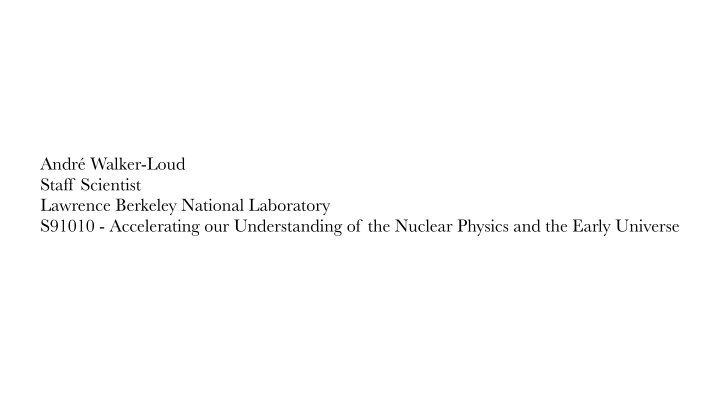



André Walker-Loud Staff Scientist Lawrence Berkeley National Laboratory S91010 - Accelerating our Understanding of the Nuclear Physics and the Early Universe
Accelerating our Understanding of the Nuclear Physics and the Early Universe André Walker-Loud
Accelerating our Understanding of the Nuclear Physics and the Early Universe André Walker-Loud
This Talk What are the driving science questions we are trying to understand? Why do we need High-Performance-Computing? How do we make optimal use of the Leadership Class Supercomputers (like Summit at Oak Ridge National Laboratory)? Preliminary new results from new machines � 3
Acknowledgements I would like to thank Jack Wells for suggesting us for this talk We would like to thank the Lawrence Livermore CORAL team Scott Futral, Greg Tomaschke, Adam Bertsch, John Gyllenhal, Py Watson for providing us early access to Sierra and help understanding how to use the machine We would like to thank the Oak Ridge Leadership Computing Facility team Jack Wells, Tjerk Straatsma, Chris Fuson, Gustav Jansen, … for providing us early access (and an Early Science Award) on Summit and help understanding how to use the machine � 4
Collaborators Nucleon Axial Coupling Chia Cheng (Jason) Chang Amy Nicholson Enrico Rinaldi Gordon Bell Evan Berkowitz Evan Berkowitz Nicolas Garron Kate Clark David Brantley Arjun Gambhir Henry Monge-Camacho Ken McElvain Chris Monahan Amy Nicholson Chris Bouchard Enrico Rinaldi Kate Clark Pavlos Vranas Balint Joó André Walker-Loud Thorsten Kurth Chia Cheng (Jason) Chang Kostas Orginos Balint Joó Pavlos Vranas Thorsten Kurth André Walker-Loud Kostas Orginos Art by Bart-W. van Lith *not all in California These calculations are made possible by DOE Topical Collaboration Double Beta Decay � 5
Science Drivers Can we understand the properties of matter (protons, neutrons, atomic nuclei) directly from the Standard Model of particle physics? Can we understand the evolution of stars from their solar fusion cycle through supernovae explosions and collapse to neutron stars and black holes (directly from the Standard Model)? See Bronson Messer’s talk just prior - we are hoping to start a new effort connecting our research Why does the universe contain more matter than anti-matter? … � 6
Standard Model of particle physics Everything we know…
<latexit sha1_base64="PqOM6i9JRb0CF+LhFy3k1Sz87NI=">ACMnicdVDLSgMxFM34tr6qLt0Ei+DClowVtRsR3bgSBatCW0smzdjQTDImd4Qy9G/8BL/CrW4UXIhbP8J0WkFDwROzrn3JvcEsRQWCHn2RkbHxicmp6ZzM7Nz8wv5xaVzqxPDeJVpqc1lQC2XQvEqCJD8MjacRoHkF0HnsO9f3HJjhVZn0I15I6LXSoSCUXBSM79XDw1l6XEzjY0GrXq4iN2FKhDFodL3PaA5+pWRPwm5OrtFjpNfMFUqr0sY0HpFxhGz5pFzGfolkKAhTpr513pLsyTiCpik1tZ8EkMjpQYEk9yNTyPKevQa15zVNGI243WrYhtRhtptnIPrzmzhUNt3FGAM/V7c0oja7tR4CojCm372+uLf3m1BMLdRipUnABXbPBQmEgMGvfzwy1hOAPZdYQyI9y3MWtTlyG4lHMuj6+l8f/kfLPk5J/ulXYPxgmM4VW0CpaRz7aQfvoCJ2gKmLoDj2gR/Tk3Xsv3pv3Pigd8Y9y+gHvI9Puyer0g=</latexit> <latexit sha1_base64="PqOM6i9JRb0CF+LhFy3k1Sz87NI=">ACMnicdVDLSgMxFM34tr6qLt0Ei+DClowVtRsR3bgSBatCW0smzdjQTDImd4Qy9G/8BL/CrW4UXIhbP8J0WkFDwROzrn3JvcEsRQWCHn2RkbHxicmp6ZzM7Nz8wv5xaVzqxPDeJVpqc1lQC2XQvEqCJD8MjacRoHkF0HnsO9f3HJjhVZn0I15I6LXSoSCUXBSM79XDw1l6XEzjY0GrXq4iN2FKhDFodL3PaA5+pWRPwm5OrtFjpNfMFUqr0sY0HpFxhGz5pFzGfolkKAhTpr513pLsyTiCpik1tZ8EkMjpQYEk9yNTyPKevQa15zVNGI243WrYhtRhtptnIPrzmzhUNt3FGAM/V7c0oja7tR4CojCm372+uLf3m1BMLdRipUnABXbPBQmEgMGvfzwy1hOAPZdYQyI9y3MWtTlyG4lHMuj6+l8f/kfLPk5J/ulXYPxgmM4VW0CpaRz7aQfvoCJ2gKmLoDj2gR/Tk3Xsv3pv3Pigd8Y9y+gHvI9Puyer0g=</latexit> <latexit sha1_base64="PqOM6i9JRb0CF+LhFy3k1Sz87NI=">ACMnicdVDLSgMxFM34tr6qLt0Ei+DClowVtRsR3bgSBatCW0smzdjQTDImd4Qy9G/8BL/CrW4UXIhbP8J0WkFDwROzrn3JvcEsRQWCHn2RkbHxicmp6ZzM7Nz8wv5xaVzqxPDeJVpqc1lQC2XQvEqCJD8MjacRoHkF0HnsO9f3HJjhVZn0I15I6LXSoSCUXBSM79XDw1l6XEzjY0GrXq4iN2FKhDFodL3PaA5+pWRPwm5OrtFjpNfMFUqr0sY0HpFxhGz5pFzGfolkKAhTpr513pLsyTiCpik1tZ8EkMjpQYEk9yNTyPKevQa15zVNGI243WrYhtRhtptnIPrzmzhUNt3FGAM/V7c0oja7tR4CojCm372+uLf3m1BMLdRipUnABXbPBQmEgMGvfzwy1hOAPZdYQyI9y3MWtTlyG4lHMuj6+l8f/kfLPk5J/ulXYPxgmM4VW0CpaRz7aQfvoCJ2gKmLoDj2gR/Tk3Xsv3pv3Pigd8Y9y+gHvI9Puyer0g=</latexit> <latexit sha1_base64="PqOM6i9JRb0CF+LhFy3k1Sz87NI=">ACMnicdVDLSgMxFM34tr6qLt0Ei+DClowVtRsR3bgSBatCW0smzdjQTDImd4Qy9G/8BL/CrW4UXIhbP8J0WkFDwROzrn3JvcEsRQWCHn2RkbHxicmp6ZzM7Nz8wv5xaVzqxPDeJVpqc1lQC2XQvEqCJD8MjacRoHkF0HnsO9f3HJjhVZn0I15I6LXSoSCUXBSM79XDw1l6XEzjY0GrXq4iN2FKhDFodL3PaA5+pWRPwm5OrtFjpNfMFUqr0sY0HpFxhGz5pFzGfolkKAhTpr513pLsyTiCpik1tZ8EkMjpQYEk9yNTyPKevQa15zVNGI243WrYhtRhtptnIPrzmzhUNt3FGAM/V7c0oja7tR4CojCm372+uLf3m1BMLdRipUnABXbPBQmEgMGvfzwy1hOAPZdYQyI9y3MWtTlyG4lHMuj6+l8f/kfLPk5J/ulXYPxgmM4VW0CpaRz7aQfvoCJ2gKmLoDj2gR/Tk3Xsv3pv3Pigd8Y9y+gHvI9Puyer0g=</latexit> To the best of our knowledge, the Standard Model matter in the Universe is comprised entirely of matter and not anti-matter radiation (photon) We observe there are more protons than anti-protons in the universe by an amount of roughly N proton � N anti − proton ' 10 − 9 matter anti-matter N photon (electron) (positron) While tiny, this is still 10,000 times or more greater than we would predict with the Standard Model - why is there so much matter in the universe?
Standard Model of Particle Physics
Formation of Matter T ≃ 1 trillion K (10 12 K) t ≃ 30 micro seconds (3x10 -5 s)
T t
Nuclear physics to the rescue! Formation of light nuclei T ≃ 1 billion K (10 9 K) t ≃ 3 minutes
Photons are liberated and run free! Formation of Hydrogen (electrons captured by protons) T ≃ 4,000 K t ≃ 380,000 years
Formation of our solar system Formation of first stars T ≃ 20 K t ≃ 200 Million years
Death of stars, creation of heavy nuclei and life , creation of new, ultradense states of nuclear matter
From Quarks to Protons and Neutrons protons and neutrons are not fundamental - but they are composite states of quarks and gluons proton neutron u d u u d d
Confinement of Quarks cooler T c ' 145 � 170 MeV ' 10 12 K computed by hot-QCD and Budapest-Wuppertal Lattice Collaborations with previous generation supercomputers
Nuclear physics to the rescue! Formation of light nuclei T ≃ 1 billion K (10 9 K) t ≃ 3 minutes
Big Bang Nucleosynthesis
Our initial condition is a soup of radiation plus a small excess amount of matter, in the form of protons, neutrons, electrons and photons
Recommend
More recommend